It began studiously enough. About 30 of us sat in rows at a series of tables,
our pens and
notebooks at ready. It could have been a class on comparative literature, but
we
weren't comparing English and Russian authors. We were evaluating the pairing
of
Canadian ice wines with cheeses.
 |
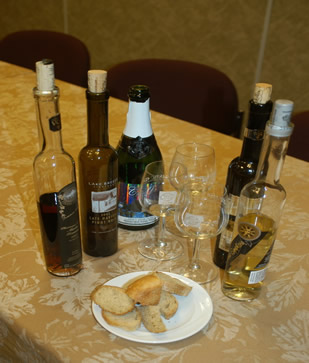 |
|
In the Classroom
|
Somewhat Later
|
I was attending one of the seminars at the 7th annual Ice Wine Festival at
Sun Peaks
Resort, a delightful ski area near Kamloops, British Columbia. The four-day
festival
combines skiing with fine dining, seminars and generous samplings of ice wine.
Ice wine is a specialty wine that's little known in the United States. Although
the history
of ice wine dates back to 1794, when it was developed in northeast Germany,
it remains a
rarely produced. Making ice wine is risky business because of temperature variables.
To
qualify as ice wine, grapes, which are left unpicked in small areas of vineyards,
can be
picked only when frozen - when temperatures range from a minimum of minus 8C
(18F)
to minus 14C (7F). The grapes, which have a water content of 80 percent, are
usually
picked about 3 a.m., often by volunteers.
The grapes are pressed while still frozen, with the frozen water driven out
as shards of
ice. The remaining juice, which is high in sugar and acid, settles for three
or four days,
is clarified by racking to the fermentation tank, then inoculated with special
yeast to start
fermentation, which can last three to four months. The result is a highly concentrated
juice
rich in sugar. British Columbia's Okanagan Valley, which has more than 65
wineries, has the necessary climate - summer heat and, most years, winter
freezing - for producing ice wine.
Not surprisingly, the first ice wine was accidental. Tilman Hainle, a winemaker
whose
father produced Canada's first ice wine, said in the late 1700s a German vineyard
owner
was away on business as the grape harvest was ending. A cold spell froze unpicked
grapes in a section of the vineyard used for late harvest wines. Later, the
vineyard owner
and his crew picked and processed the grapes, resulting in an intensely sweet
and syrupy
wine then called "Winter Wine." It wasn't until 1962 that commercial
ice wines were
produced in Germany and, eventually, throughout Europe.
In Canada, Tilman Hainle's father, Walter, established Hainle Vineyards and
Estate
Winery at Peachland, B.C., and produced the country's first ice wine in 1974.
Ice wine is
now made by several other B.C. wineries, mostly in the Okanagan Valley.
"The original name for ice wine is, 'Damn, I forgot to pick the grapes,"
said Hainle, the
winemaker for Deep Creek Wine Estate/Hainle Vineyards. "They're like frozen
marbles
on the vine."
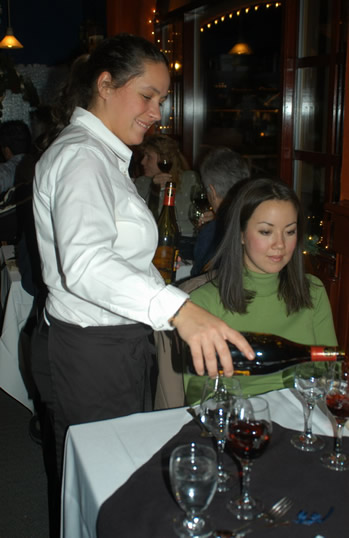 |
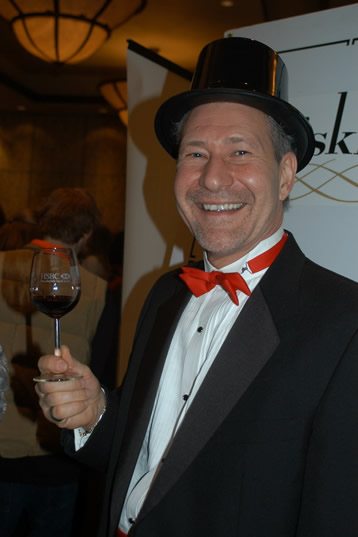 |
|
A Pour for a Princess
|
Winetasting Around Town
|
When served, usually by itself or with dessert, ice wine is chilled. And savored.
Ice wine
isn't just any wine. A bottle, which contains only 375 milliliters, costs anywhere
from $35
to $200. Our ice wine was being served with blue cheeses so the seminar was
appropriately titled, "Art of Cheese and Wine Pairing: Stinky Wine and
Cheese." In front
of each of us were placemats, each with nine neatly drawn circles. Set on the
circles were
wine glasses, each with about an ounce of late harvest and ice wines. In each
circle were
the names of the wines, including Riesling, Merlot, Gewurztraminer, Vidal and
Pinot
Noir. Nearby were labeled containers, each partially filled with deliciously
stinky
Canadian blue cheeses - ermite, benedictin, tiger, beddis, borgonzola and more.
Our
speakers, experts in ice wine and cheese, scribbled information on a blackboard.
Many of
us copied the information into our notebooks.
Over the first half-hour the questions were probing, erudite and studied, queries
about
second fermentations, acidity and botrytis cinerea, or conditions that causes
hanging
grapes to rot. It was instructive. Along with wine, we learned about handling
cheese,
from letting it set for an hour before tasting, and "palming," holding
cheeses in the hand
to bring out the scent.
"Let's get started," the wine expert announced, adding a cautionary,
"There's quite a high
sugar content and, as you will find, you get quite buzzed."
At first, we assiduously swirled our glasses, took deep sniffs, tilted the
glasses and took
measured sips. We nibbled selected cheeses, sipped the wine, then nibbled again
before
moving to different cheese and wine combinations, after munching bread and drinking
water to, ahem, clear our palates. The speaker described the smell of one ice
wine as
"like smelling a David Austin rose" and declared that another tasted
"waxy, like your mother
used on the wood floors of your house."
As we continued sampling, the speaker's voice softened, and the samplers' increased.
The
swishing was forgotten, the palate cleansing less frequent, the wine sampling
more like
wine slurping.
"A bottle of this," one person quipped, referring to the high sugar
content, "and we'll be
glued to the ceiling."
When the speaker asked, "What pairing really struck out to you the most?"
the
increasingly jocular sampler a few seats from me barked, "The cheese and
the wine!"
then stood and bowed while accepting a round of raucous applause. My own legible
notes
stop there, degenerating into illegible scribbles.
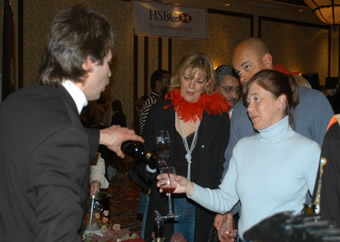 |
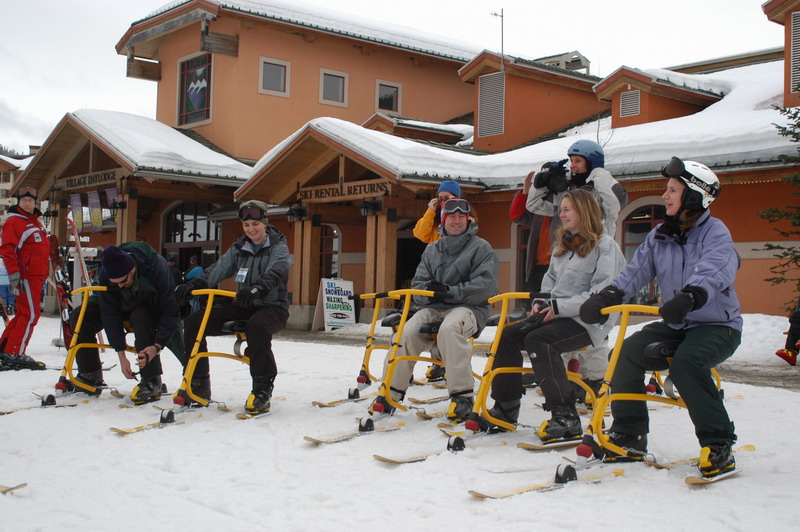 |
|
A Twist of the Wrist
|
Full of Fuel and Ready to Romp
|
* * *
It wasn't all hard work. Over portions of four days we spent mornings downhill
skiing or
riding snowbikes. We attended other seminars, tasted desserts made with ice
wine
and ate sumptuous dinners, replete with even more generous samplings of ice
and other
Okanagan wines.
The major event happened the Saturday night 650 of us waltzed through the Tyrolian
styled Sun Peaks village sampling the offerings from 20 Okanagan wineries. At
the
seminar, after our speaker loosened up, he advised us to pin a piece of paper
on the back
of our jackets with our names, motel and room numbers "in case someone
finds you face-
planted in the snow."
Things never got quite that out of control, darn it.
* * *
Information about ice wines, the 2006 Ice Wine Festival and the Okanagan region
visit
the Tourism British Columbia Web site at www.HelloBC.com or call (800) 435-5622;
visit the Okanagan Wine Festivals Web site at www.TheWineFestivals.com or call
(250)
861-6654; or Sun Peaks Resort at www.sunpeaksresorts.com or (800) 807-3257.
Package
festival rates are available. Learn more about Hainle Vineyards at www.hubercorp.com
or call (800) 767-2525.
* * *
Lee Juillerat is the regional editor for the Herald and News newspaper in Klamath
Falls, Oregon. He has written travel and adventure stories about national and
international destinations for High on Adventure for nine years. He's also had
more than 100 stories and photographs in a variety of magazines, including Alaska-Horizon
Airlines in-flight publications, Northwest Travel, Oregon Coast, Range, Sunset
and Oregon Outside, among others. He can be contacted at lee337@cvc.net.